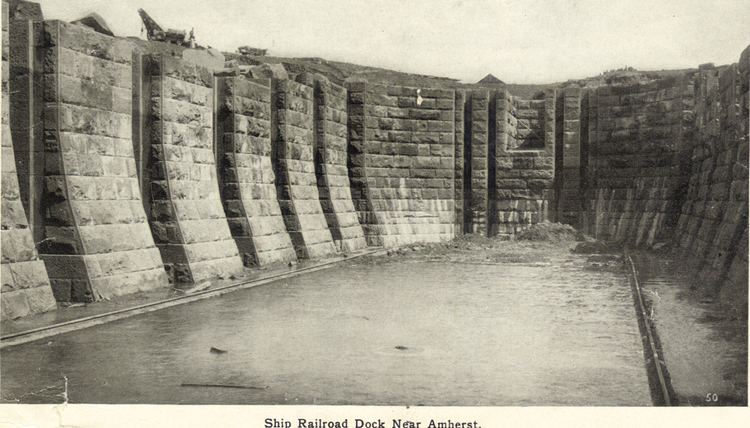 | ||
The Chignecto Ship Railway is a historic Canadian portage railway located in Cumberland County, Nova Scotia.
Contents
The project was first proposed in 1875 by notable civil engineer Henry Ketchum as a means to transport ships across the Isthmus of Chignecto, shortening the sailing distance between the Bay of Fundy and the Gulf of St. Lawrence by avoiding the necessity of sailing 500 nmi (930 km) around Nova Scotia. A canal had been proposed for the isthmus but financing was proving difficult to secure. Ketchum submitted his proposal to the Government of Canada in 1881. In 1882 the Chignecto Marine Transport Railway Company was incorporated as a federally chartered railway. It was financed by Baring Brothers and Company, London.
In 1685 during an inspection of the now defunct Acadian settlement of Beaubassin, intendant Jacques de Meulles reported that the one league portage could be made into a ditch, since the elevation is low.
Design
The ship railway was designed to carry vessels weighing up to 2000 tons with a proposed transit time of 2.5 hours. Ships would be carried on a cradle forming an extremely wide rail car that straddled parallel twin standard gauge railway tracks, separated by 18 ft (5.5 m) to the centre of each track.
The tracks were built on a route that was almost perfectly straight for a distance of 17 mi (27 km) between the southwestern terminal on the Bay of Fundy, located at Fort Lawrence and the northeastern terminal on the Northumberland Strait, located at Tidnish Cross Roads.
At each terminal the twin railway tracks descended on an incline into a stone-lined basin similar to a drydock which ships would float in and out. Each terminal had a lifting dock containing a steel grid measuring 235 ft (72 m) by 60 ft (18 m) connected to 20 hydraulic jacks. The grids supported the cradle which carried the vessel. The cradle was pulled from the lifting dock by hydraulic power and was then pulled along the length of the ship railway by 2 steam-powered locomotives.
The terminal at Tidnish Cross Roads was located on Baie Verte and had a moderate tidal range and was protected by two breakwaters. However, the terminal at Fort Lawrence was located on Cumberland Basin at the discharge point of the Missaguash River on the inter-provincial boundary with New Brunswick and had a high tidal range, necessitating the construction of a lock to accommodate different water levels.
Construction and demise
Construction began in October 1888 and by 1890 the project was three-quarters complete with 16 mi (26 km) of the rail bed finished, and 13 mi (21 km) of the track laid. A bridge and large stone arch culvert were built at Tidnish Bridge - a community which received its name due to this infrastructure. And the terminals were built including the docks, breakwaters, and lock.
In fall 1890 the primary financiers of the project, Baring Brothers & Co., faced potential insolvency due to the financing of debts in Uruguay and Argentina. This created the Panic of 1890. By August 1891 work on the ship railway ground to a halt and would never restart. Ketchum appealed to the federal government for help in finishing the project but in 1892 the Parliament of Canada refused to extend the time period for the contract with the Chignecto Marine Transport Railway Company.
Ketchum never ceased lobbying for the project but died unexpectedly on September 8, 1896, in Amherst. He was buried in Tidnish Bridge at a cemetery that overlooked the unfinished ship railway.
Remnants
Eventually the tracks were pulled up and recycled while nature slowly claimed the rail bed. Most of the rail bed is still visible in aerial and satellite photos in the 21st century and supports several recreation trails. The land for the right of way was purchased by the Government of Nova Scotia in 2012. The docks at Fort Lawrence and Tidnish are still visible to this day; the dock at Tidnish being part of the Tidnish Dock Provincial Park. Some of the stones used for the breakwaters at Tidnish were moved in 1917 to Cape Tormentine and used in the construction of the docks used for ferry service to Prince Edward Island.
